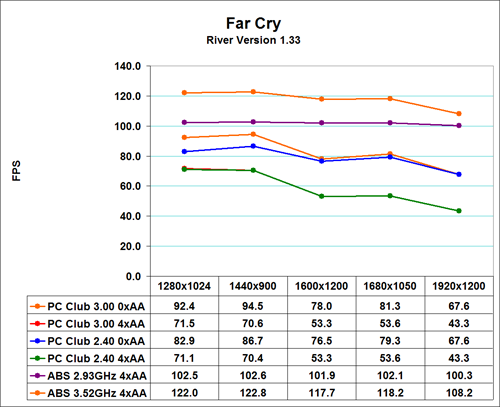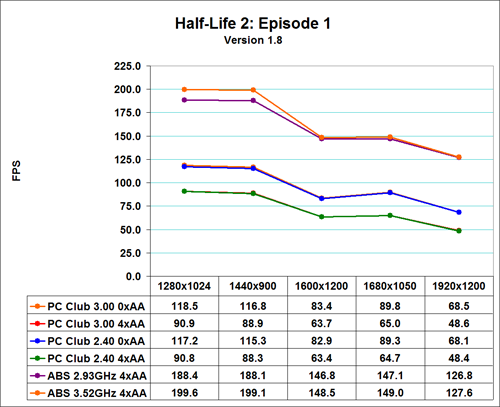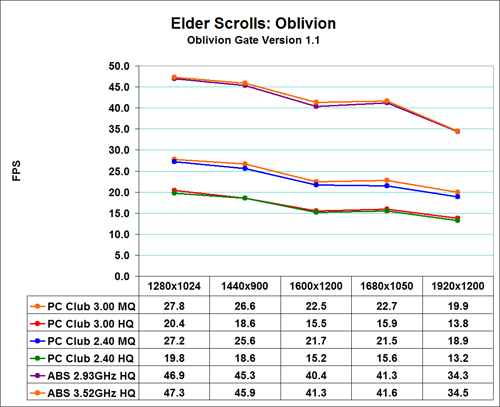PC Club Enpower Sabre Extreme: E6600 Made Easy
by Jarred Walton on August 29, 2006 4:40 AM EST- Posted in
- Systems
Gaming Resolution Scaling
As this is a system review, we wanted to also look at gaming performance that can be achieved using the Sabre Extreme at lower resolutions and/or detail settings. We tested the five most commonly used resolutions for modern LCD displays at "high" and "medium" settings. We have provided a chart below of the test settings used for "midrange" and "high-end" configurations. Here are the results, along with scores from the ABS Ultimate X9. All of the results are with sound enabled where possible, as this is how most people play games and it reflects testing the performance of the entire package rather than individual components.






It should come as little surprise that the ABS Ultimate X9 is faster than the PC Club Sabre Extreme in every situation, especially at higher detail settings. Given the graphics configuration of the ABS Ultimate X9, we did not bother testing without antialiasing (except in Oblivion and SS2 due to the use of HDR), as performance is more than acceptable so there's no need to drop detail levels. The Sabre Extreme on the other hand can definitely benefit by running at slightly reduced detail settings, especially at higher resolutions.
Even the ultra high end ABS Ultimate X9 is running into GPU limitations, so the performance comparisons here essentially amount to comparing different GPUs. At present, the vast majority of games depend more on graphics performance than CPU performance, so with the exception of flight simulators and certain strategy games, GPU performance really does equate to gaming performance. That being the case, if you need help deciding whether or not you should upgrade the graphics card in a prebuilt system, you can always refer to our video card reviews.
You can see the GPU limited nature of games by looking at the stock vs. overclocked performance of both the ABS and PC Club computers; even with a top-end GPU configuration, CPU performance really only impacts gaming at the lower resolutions, and when you're talking about a 5% or less difference in performance, it really won't matter too much which Core 2 Duo CPU you use for gaming. Perhaps future games will be able to place more of a burden on the CPU, but that doesn't appear too likely, as games like Unreal Tournament 2007 and the recently released Prey are more GPU limited than current titles.
If you choose to go with a 19" widescreen ViewSonic LCD like the one PC Club sent us, the maximum resolution of 1440x900 is playable in nearly all cases at high detail settings. If you would rather use a larger monitor and/or run at higher resolutions, you may find it necessary to drop antialiasing down to 2xAA and/or reduce other settings. Whatever route you go, however, the gaming performance offered is more than acceptable for all present titles; you just may find that you need to tweak settings a bit in order to find the right balance between resolution, detail, and frame rate.
As this is a system review, we wanted to also look at gaming performance that can be achieved using the Sabre Extreme at lower resolutions and/or detail settings. We tested the five most commonly used resolutions for modern LCD displays at "high" and "medium" settings. We have provided a chart below of the test settings used for "midrange" and "high-end" configurations. Here are the results, along with scores from the ABS Ultimate X9. All of the results are with sound enabled where possible, as this is how most people play games and it reflects testing the performance of the entire package rather than individual components.
| Game Settings | ||
| Medium Quality | High Quality | |
| Battlefield 2 | All settings at high with 0xAA | All settings at high with 4xAA |
| Far Cry | All settings at Very High with 0xAA/8xAF Water at Ultra High |
All settings at Very High with 4xAA/8xAF Water at Ultra High |
| HL2: Episode 1 | All settings on high HDR and color correction enabled 0xAA/8xAF |
All settings on high HDR and color correction enabled 4xAA/8xAF |
| Oblivion | Ultra High Defaults (Max) except: Grass: 0% Interior/Exterior Shadows: 25% Self Shadows: Off Shadows on Grass: Off Tree Canopy Shadows: Off Shadow Filtering: Off Specular Distance: 50% HDR: On (AA: Off) |
Ultra High Defaults (Max) except: Grass: 50% Interior/Exterior Shadows: 50% Self Shadows: Off Shadows on Grass: Off HDR: On (AA: Off) |
| Quake 4 | High defaults with 0xAA SMP enabled |
High defaults with 4xAA SMP enabled |
| Serious Sam 2 | High Detail Defaults High Texture Size HDR Enabled (AA Off) |
Maximum Detail Defaults HDR Enabled (AA Off) |






It should come as little surprise that the ABS Ultimate X9 is faster than the PC Club Sabre Extreme in every situation, especially at higher detail settings. Given the graphics configuration of the ABS Ultimate X9, we did not bother testing without antialiasing (except in Oblivion and SS2 due to the use of HDR), as performance is more than acceptable so there's no need to drop detail levels. The Sabre Extreme on the other hand can definitely benefit by running at slightly reduced detail settings, especially at higher resolutions.
Even the ultra high end ABS Ultimate X9 is running into GPU limitations, so the performance comparisons here essentially amount to comparing different GPUs. At present, the vast majority of games depend more on graphics performance than CPU performance, so with the exception of flight simulators and certain strategy games, GPU performance really does equate to gaming performance. That being the case, if you need help deciding whether or not you should upgrade the graphics card in a prebuilt system, you can always refer to our video card reviews.
You can see the GPU limited nature of games by looking at the stock vs. overclocked performance of both the ABS and PC Club computers; even with a top-end GPU configuration, CPU performance really only impacts gaming at the lower resolutions, and when you're talking about a 5% or less difference in performance, it really won't matter too much which Core 2 Duo CPU you use for gaming. Perhaps future games will be able to place more of a burden on the CPU, but that doesn't appear too likely, as games like Unreal Tournament 2007 and the recently released Prey are more GPU limited than current titles.
If you choose to go with a 19" widescreen ViewSonic LCD like the one PC Club sent us, the maximum resolution of 1440x900 is playable in nearly all cases at high detail settings. If you would rather use a larger monitor and/or run at higher resolutions, you may find it necessary to drop antialiasing down to 2xAA and/or reduce other settings. Whatever route you go, however, the gaming performance offered is more than acceptable for all present titles; you just may find that you need to tweak settings a bit in order to find the right balance between resolution, detail, and frame rate.










30 Comments
View All Comments
nah - Tuesday, August 29, 2006 - link
Good work, as always. How about an update on the CPU?GPU guides ?modo - Tuesday, August 29, 2006 - link
Just went over to ibuypower.com and configured a Core 2 duo E6600 with the MSI 965 mobo, 500W PSU, 1 gig ram, 250 gig HD, 7900Gt 256mb, dvd burner, with a mini-liquid cooler for the cpu for $1245 (without monitor). Enter 'ibuypower' code when you order and you get 5% off, taking the total down to less than $1200.Better system for $200 less?
JarredWalton - Tuesday, August 29, 2006 - link
Add in the OS and monitor, and the total comes to $1522 with the discount. ($1361 without $229 LCD = $1293 with discount.) You need a 16MB cache HDD and a DVDRW with LightScribe if you want to make things "equal" on components. You can also add some extras that may or may not be available elsewhere. Anyway, it's still slightly cheaper; is it worth considering? Sure - it comes with a 3 year warranty. How's the support? I don't know. As stated in the conclusion, PC Club has some reasonable offers people might want to look at - especially if you live near a local store and would like that sort of support. There are a ton of competing system vendors out there.yyrkoon - Tuesday, August 29, 2006 - link
MSI . . . I can not speak for everyone else, but I've had less than good results using MSI products. They may work fine for a period of time, but can not really be comparred to someone like ABIT, or Gigabyte. Who makes the PSU ? Why do you need a 'mini-liquid cooler' ?I've personally configured (but not bought) a simular C2D budget system, but using a E6400, and a 7600GT, and overall cost was around $800usd. Of course, I had planned on migrating a PSU (Antec), and HDDs from an older system. This is why I almost always suggest quality parts, as quality parts often last for years, and can be reused (in the case of a PSU, and HDDs here). You can go even cheaper if you use something along the lines of the Asrock 775Dual-VSTA motherboard, and migrate memory, and video from current system. *shrug* My personal experience with Asrock however, is that usually they are very solid boards (for the price), but are often less than top tier stable, and more often then not, are fairly quirky, and missing Features such as offering a SATAII controller, but disabling (or not including) command queuing(which is part of the SATAII spec, unless I'm mistaken).
QueBert - Wednesday, August 30, 2006 - link
funny, while I don't really care for MSI, never had a problem with them. Now Gigabyte UGH, on my 3rd board right now for this 939. And my last Gigabyte board (Athlon XP) gave me problems from day one. It's crazy how one person can never have a problem with a brand, and the guy next to him has nothing but problems. I think MSI has gotten a lot better then they were in the past. I live 2 blocks from a PC Club, and i can tell you this, whatever prebuilt systems they sell, they've done A LOT of component testing. As I've never heard somebody complain about an Enpower system, besides those who screw things up themselves with viruses and such. I only shop at PC Club, unless it's something they don't carry. They cost a bit more then Newegg, but the service is great. I walk in, they know me by name. They sold me a MB + Memory, I was dumb and didn't check, the MB was DDR2 and the memory was DDR1, I wanted DDR1, so they took the open MB back, no hassle.bob4432 - Tuesday, August 29, 2006 - link
Nice article and seems like a decent system for the $$$$. One question - where can we get the bf2 1.3 benchmark you are using?thanks,
bob :)
JarredWalton - Tuesday, August 29, 2006 - link
Sure, http://images.anandtech.com/reviews/benchmarks/bf2...">have at it. Standard "this is beta" disclaimers apply. If you don't know how to tweak a batch file, you're on your own. :)--Jarred Walton
bob4432 - Wednesday, August 30, 2006 - link
thanks, i had the 1.22 but lost it, then 1.3 came out.regnez - Tuesday, August 29, 2006 - link
why is that in the feature list the graphics card is a 7900gt and in the benchmark setup it is a 7900gtx? is this a typo or was the graphics card switched out for the benchmark setup?also, it does not seem as if a 350 watt psu is enough to power that graphics card...
and one more thing: this system is called a mid-range system in the review, and I quite disagree. a mid range system would be something in the price range of $700-$900. this is a high end system, and it would not take much ($400 ish more) to bring it up to enthusiast level.
JarredWalton - Tuesday, August 29, 2006 - link
It was a typo; the system (as configured and tested) uses the 7900 GT. In terms of power, look at the power tests on page 9. Even with a 25% overclock and maximum load, the system draws 213W of power. That's not even accounting for PSU efficiency; remember that the PSU rating is what can be output, not the total wall power draw. Say it's 75% efficient; that means the system is using about 160W of power at maximum load. I've got a few generic 350W PSUs running similar configurations, and none of them have ever had issues.Finally, there is always debate about where market segments overlap price ranges. We consider budget to be $750 or less (maybe a bit more for budget gaming). Midrange is a huge segment that goes from around $1000 to $1500. At ~$1600, this is close enough, though it's definitely at the top of the midrange ladder. High-end starts at $2000 and can go way up from there. It's just a term anyway, and if you think $1500 is too high you're welcome to that opinion. The base configuration of the EN-SE5 comes with an E6300, 7300GS TurboCache, 160GB HDD, and costs $800 (including the OS). It's not longer really gaming worthy, but it will do everything else very well.